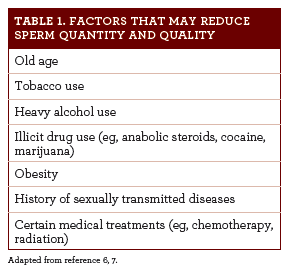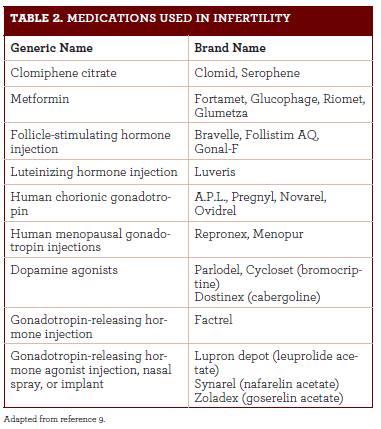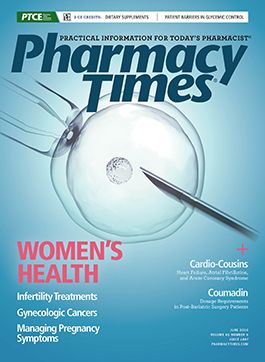Publication
Article
Pharmacy Times
Infertility Treatment: The Pharmacist's Expanding Role
Author(s):
The use of fertility-enhancing medications has increased drastically over the past 30 years, with the role of the pharmacist continuing to expand within that specific niche of pharmacy.
Infertility has been defined as “the inability to conceive after 12 months of unprotected intercourse.” Women aged 35 or older, who are unable to conceive after 6 months, are generally considered infertile, as well.1,2 According to the CDC, 6.1% of married women are considered infertile, with nearly 7 million of them receiving some form of infertility services during their lifetime.3 The use of fertility-enhancing medications has increased drastically over the past 30 years, with the role of the pharmacist continuing to expand within that specific niche of pharmacy.
CAUSES OF INFERTILITY
The causes of infertility are often complex, with several factors contributing to the inability to conceive. One or both partners may contribute to a couple’s infertility, with male issues accounting for one-third of infertility cases.4 Male infertility is often the result of a hormonal imbalance or blockage of sperm movement.5 An enlarged vein in the testicle, known as a varicocele, is thought to be the most common cause of male infertility, although this theory is controversial.5 Several factors affecting a man’s overall health and lifestyle may reduce his sperm quality and quantity, resulting in an increased risk of infertility (Table 16,7). Approximately one-third of infertility is caused by a combination of problems or is unexplained, and one-third of cases of infertility can be attributed to the female partner.4 Ovulatory disorders, abnormalities of the uterus or outflow tract, and tubal disease or dysfunction account for the majority of female infertility cases.

TREATMENT
Treatment of infertility depends on several factors, including diagnosis, duration of infertility, and age. Any underlying factors affecting fertility should be managed accordingly.8 Assisted reproductive technologies (ART) are often used to help affected individuals achieve pregnancy. These procedures are frequently done in combination with the use of medications to improve pregnancy success rates (Table 29).

Clomiphene Citrate9,10
Clomiphene citrate is the most commonly prescribed ovulation medication and is primarily prescribed for women who have rare or absent ovulation. This oral medication works by competitively inhibiting estrogen receptors, resulting in increased levels of follicle- stimulating hormone (FSH) and luteinizing hormone (LH), which subsequently promotes follicle development and ovarian stimulation.
Clomiphene citrate induces ovulation in approximately 80% of cases and should not be given for more than 6 cycles. Women should be informed that conception while taking clomiphene is associated with a 30% chance of delivering twins. Women who have ovulation abnormalities due to hypothalamic disorders or very low estrogen levels generally do not respond well to clomiphene. The adverse effects (AEs) of clomiphene are considered mild, with 10% of women experiencing hot flashes.
Gonadotropins9,11
Gonadotropins are injectable fertility medications containing exogenous FSH and LH. These medications are often used in women who have failed clomiphene therapy and are used to induce development of multiple follicles for procedures such as intrauterine insemination or ART. Human chorionic gonadotropin is another injectable gonadotropin that is used to trigger the release of mature eggs. This group of medications is associated with multiple births, an increased incidence of miscarriage and premature delivery, mood swings, breast tenderness, and injection-site reactions.
Metformin9,12
Polycystic ovary syndrome (PCOS) is a common hormonal condition in which women produce an increased amount of androgens, resulting in irregular, or a lack of, ovulation. Metformin has been shown to restore cyclic ovulation and menses in some women who suffer from PCOS, while lowering elevated blood glucose levels. AEs of metformin include increased gastrointestinal discomfort, and the medication is contraindicated in certain patients with renal dysfunction.
Dopamine Agonists9
Some women ovulate irregularly because their body secretes an increased amount of prolactin, which inhibits the release of FSH and LH and, in turn, prevents ovulation. This class of agents reduces excess amounts of prolactin released by the pituitary gland and is thought to normalize prolactin levels in most patients. These oral medications often cause fatigue, headaches, fainting, nausea, and vomiting, and should be discontinued during pregnancy.
Gonadotropin-Releasing Hormone Analogs9
Gonadotropin-releasing hormone (GnRH) is released from the hypothalamus and stimulates the pituitary gland to secrete LH and FSH. In the absence or improper release of GnRH, women are unable to ovulate regularly. GnRH analogs are synthetic agents that have a structure similar to that of natural GnRH. This class of medications is used to prevent spontaneous ovulation in women receiving gonadotropins for in vitro fertilization. AEs often seen with the use of GnRH antagonists and agonists include hot flashes, mood swings, and vaginal dryness. These AEs are thought to subside once these medications are discontinued.
CONCLUSION
The pharmacist is an excellent resource for patients using these medications for the treatment of infertility.13 The regimens are often complicated and require a sound understanding for optimal results. Pharmacists can answer questions regarding administration and safety of the medications, while discussing treatment options and assisting with referrals, if needed.13
Clarence D. Moore, PharmD, BCPS, is assistant professor at Howard University College of Pharmacy.
References
- Defining infertility. ReproductiveFacts.org website. www.reproductivefacts.org/uploadedFiles/ASRM_Content/Resources/Patient_Resources/Fact_Sheets_and_Info_Booklets/Defining%20inertility%20FINAL%20%202-19-14.pdf. Accessed February 13, 2016.
- Infertility FAQs. CDC website. http://www.cdc.gov/reproductivehealth/infertility/index.htm. Accessed February 13, 2016.
- Key statistics from the National Survey of Family Growth. CDC website. www.cdc.gov/nchs/nsfg/key_statistics/i.htm#infertility. Updated April 20, 2015. Accessed February 13, 2016.
- Male infertility. US National Library of Medicine website. www.nlm.nih.gov/medlineplus/maleinfertility.html. Accessed February 14, 2016.
- Kantartzi PD, Goulis ChD, Goulis GD, Papadimas I. Male infertility and varicocele: myths and reality. Hippokratia. 2007;11(3):99-104.
- What increases your risk of infertility? Healthline website. www.healthline.com/health/fertility/risk-factors#Overview1. Accessed February 16, 2016.
- Infertility. Mayo Clinic website. www.mayoclinic.org/diseases-conditions/infertility/basics/definition/con-20034770. Published July 2, 2014. Accessed April 13, 2016.
- Puscheck EE. Infertility. Medscape.com website. emedicine.medscape.com/article/274143-overview. Updated March 30, 2015. Accessed February 16, 2016.
- Medications for inducing ovulation: a guide for patients. American Society for Reproductive Medicine website. https://www.asrm.org/uploadedFiles/ASRM_Content/Resources/Patient_Resources/Fact_Sheets_and_Info_Booklets/ovulation_drugs.pdf. Accessed February 17, 2016.
- Moy I, Ekpo G. Clomiphene citrate use for ovulation inductions: when, why, and how? Contemporary OB/GYN website. contemporaryobgyn.modernmedicine.com/contemporary-obgyn/news/clinical/clinical-pharmacology/clomiphene-citrate-use-ovulation-induction-wh?page=full. Accessed February 18, 2016.
- What are gonadotropins? American Society for Reproductive Medicine website. asrm.org/FACTSHEET_Side_effects_of_injectable_fertility_drugs_gonadotropins/. Accessed February 18, 2016.
- Infertility and polycystic ovary syndrome. WebMD.com website. webmd.com/infertility-and-reproduction/polycystic-ovary-syndrome?page=2. Accessed February 19, 2016.
- Smith C, Grimm M, Schwegel M. Treatment of infertility in women. J Am Pharm Assoc (2003). 2012;52(4):e27-e42. doi: 10.1331/JAPhA.2012.12044.







